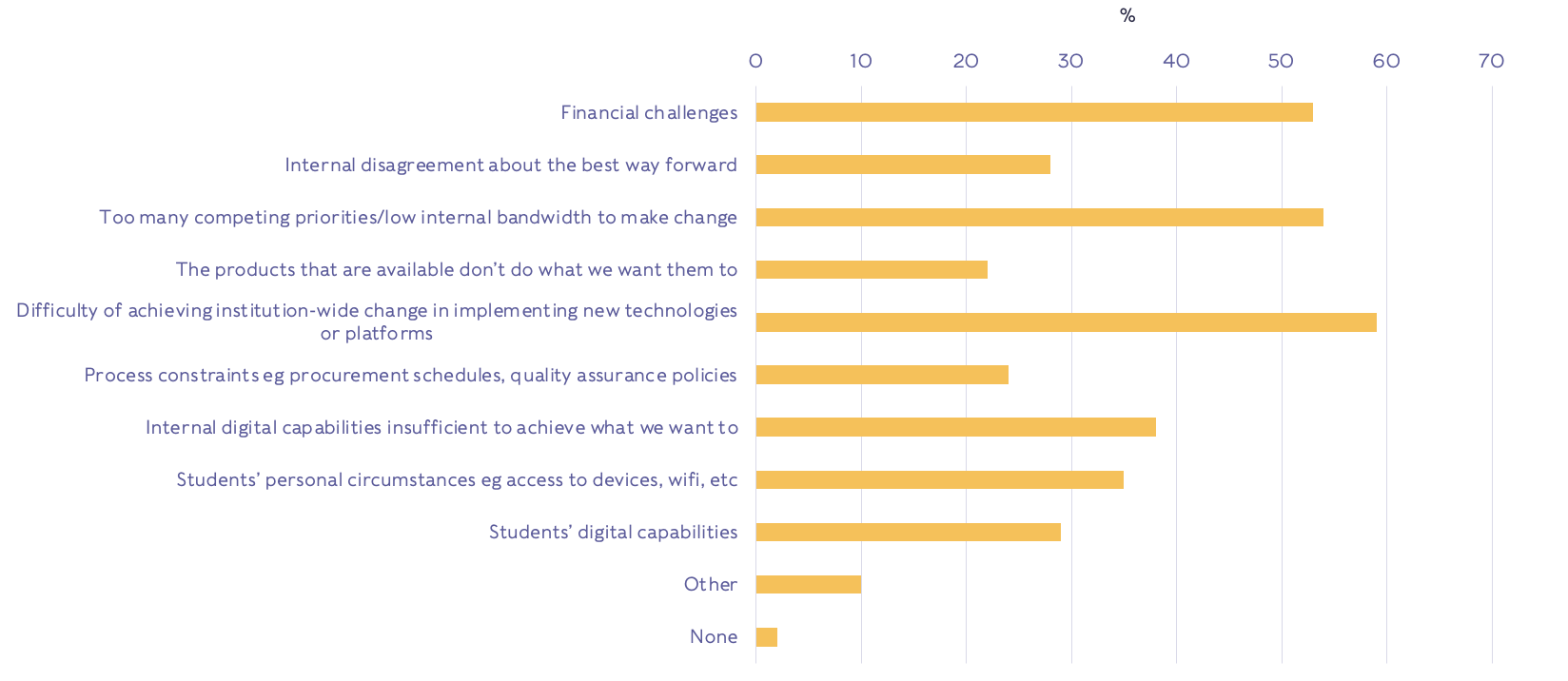Achieving institution-wide change in higher education is often challenging but digital transformation is especially complex, requiring fundamental reshaping of systems and process, and culture and practice across the organisation.
This was confirmed in the Wonkhe/Kortext survey of educators, where we asked about the challenges institutions are facing that are creating constraints in the implementation of plans for digitally enhanced learning, teaching, and student support. “The difficulty of achieving institution-wide change” came top, selected by 59 per cent of respondents. Second was “too many competing priorities/low bandwidth” (54 per cent), closely followed by “financial challenges” (53 per cent) – reminding us that UK universities are often seeking to invest in digital technology at the same time their overall resource is eroding. Only two per cent of respondents said they had no challenges.

Chart: What challenges is your higher education provider facing that are creating constraints in the implementation of plans for digitally enhanced learning, teaching, and student support? Select all that apply (%)
We followed up the questions about challenges by asking what respondents think their institutions are doing well and what they think they could be doing better to support digitally enhanced learning, teaching, and student support.
What respondents say is working well
The bulk of commentary on good practice related to the themes of staff expertise, development, and student support.
Retaining expert staff – central IT and learning technologist teams, but also academic digital innovation leads, digital accessibility teams, helpdesk/drop-in support staff, and (paid) student digital mentors
Efforts to develop staff and share practice – including formal training, bite-sized provision, and less formal peer review and community of practice arrangements
Attention to students’ needs – skills assessment and support, action to tackle digital inequality, embedding high accessibility standards in course materials, solicitation of feedback from students
There were also more specific comments on digital innovations, partnerships and effective change management:
- Innovations or examples of effective practice – including use of VR and AR; creating new microcredentials; polling software and interactive whiteboard used for classroom teaching; additional “digital curriculum” to support traditional learning and teaching activity; hybrid classrooms
- External partnerships with technology providers
- Effective project/change management practice
- Mandating consistency of standards and/or practice
- Building internal student data infrastructure
- Adoption of digital literacy as a graduate attribute
“Coordinated strategy to redraw learning, teaching and assessment landscape aligned with investment in digital solutions and digital skills (staff and students). Member of executive team, post-92 university
We have a dedicated teaching enhanced learning team who provide support and develop digital teaching resources. They are fabulous, but a small team. Personal relationships with this team enhance the ability to embed digital technologies. Academic, post-92 university
Using positive digital communities to support learning as well as social interaction. This is in relation to courses and programmes for both staff and student involvement. Learning and teaching professional, pre-92 university
What could be improved?
The majority of comments about what could be improved focused on how staff and students are engaged with institutional strategy and practice, and supported to develop their capabilities. There was also a desire for more joined-up systems and a general sense that lots of things needed to be “better” – where people experience technology as clunky or inefficient, it reduces their appetite to use it. Mapping the range of “user journeys’ with technology for different staff roles and student demographics could help to address some of these pain points.
More thought given to engaging and developing staff and students – acknowledging/addressing heavy workloads; more effective communications; more cooperation between academic and professional teams; more critical engagement with academic challenge and more respect for academic “on the ground” insight
Join-up/coordination of systems and strategies – building up digital architecture; more joined up systems; investment in strategy as a whole rather than just systems; coming to a conclusion about institutional approaches to hybrid work and learning (some are more in favour of in-person, others of hybrid, but most often what is wanted is clarity)
More investment in development and training – tackling a lack of digital skills; the challenge of training at scale; more tailored/varied training provision
Retention of core academic values in digital practice – valuing community, connection, pedagogy, not just efficiency and cost-savings
Better systems – better platforms, better connectivity; better accessibility; better quality data; better physical estate
Thinking beyond substitution, thinking what is possible with technology rather than simply substituting previously analogue activities in exactly the same form digitally (e.g. considering how assessment can be enhanced, rather than examinations being moved online in exactly the same fashion as in-person exams but just typed). Learning and teaching professional, pre-92 university
Reduce the number of systems used to maintain records, support students and keep the university running. We have systems upon systems upon systems, and many don’t talk to each other well. Or you have one system, updating another and then that system updating further systems…. information is 3rd hand by this point. Something is bound to go wrong. Learning and teaching professional, post-92 university
Digital transformation is about people and practices, not just processes and technology
Heidi Fraser-Krauss, Chief executive, Jisc
Digital transformation is all about using technology appropriately to better meet the needs of students and staff. To be successful, it needs a series of deep and coordinated shifts in culture. Taking a strategic, organisation-wide approach to these critical changes is vital for the long-term success and sustainability of UK universities.
While the basis for digital transformation remains a robust, secure digital, data and physical infrastructure, in many ways, these foundational elements are the easiest to get right. Networks, hardware, software – all these can be planned, implemented and managed through tried and tested processes. Once the technology is in place, it will quietly get on with the job, without arguing back.
The hard bit is the values, beliefs and practices affected by digital technology – and this is where we need to direct the most attention. In other words, people, not technology, should be the major focus of the transformation process. As Peter Drucker’s famous quote goes, “Culture eats strategy for breakfast.” Changing the digital culture across a whole institution is a much more complex proposition than putting in place the technology to enable it.
To help higher education providers address the complexities and scale that make whole institution change so challenging, Jisc’s Framework for digital transformation offers a holistic structure to guide them through the process. Drawn from the collective wisdom of the sector, this framework encourages a collaborative, whole-organisation approach that encompasses people and practices, not just processes and technology.
The aim is to help institutions articulate a strategic vision for digital transformation and develop actionable plans to achieve it. By highlighting how policies and processes might align to promote cross-team approaches, the framework reduces complexity, unifies fragmented processes and informs accurate decision-making across the organisation.
As every institution has its own specific needs and culture, the framework is designed to be flexible enough to enable each one to navigate digital transformation in their own way. Some might benefit from simply upgrading existing systems, while others might need to explore completely new ways of using digital to solve complex organisational challenges. For example, the University of Greenwich recently shared top tips on achieving digital transformation using the Jisc framework, and the University of Northampton shared the importance of building “a culture of curiosity.”
Aligned to the framework is Jisc’s maturity model for digital transformation. Published in September alongside a digital transformation guide for higher education, the model provides a structure to help institutions assess their digital maturity across all areas, benchmark themselves against the sector, and set their own baseline from which to move forward.
The complexities of HE provider activities are reflected in the scale and size of the framework and maturity model. They provide a common approach to recording engagement and producing action plans, and can be tackled in sections by different individuals and teams. Staff can quickly see where their areas of responsibility fall, enabling them to focus on specific areas. Senior leaders can gain an immediate understanding of plans, priorities, and progress, and align them at a strategic level.
Together, these tools help institutions produce an organisation-wide roadmap for digital transformation that embraces not just technology and data but also the overall values and principles that make up their individual digital culture.
This article is published in association with Kortext as part of a suite on the theme of universities deploying technology for learning, teaching, and student success. You can download the full report of the survey findings and leaders’ insight over on Kortext’s website here.














